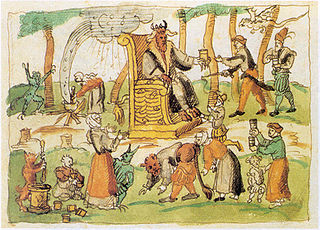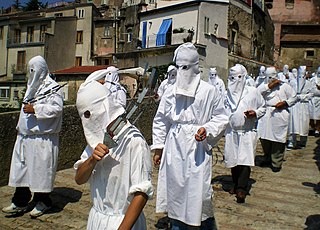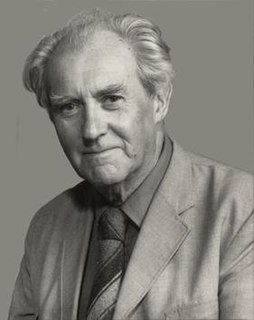Related Research Articles
Millennialism or chiliasm is a belief advanced by some religious denominations that a Golden Age or Paradise will occur on Earth prior to the final judgment and future eternal state of the "World to Come".
Millenarianism, from Latin mīllēnārius "containing a thousand", is the belief by a religious, social, or political group or movement in a coming fundamental transformation of society, after which "all things will be changed". Millenarianism exists in various cultures and religions worldwide, with various interpretations of what constitutes a transformation.
Psychogeography is an exploration of urban environments that emphasizes playfulness and "drifting". It has links to the Lettrist and Situationist Internationals, revolutionary groups influenced by Marxist and anarchist theory, and the attitudes and methods of Dadaists and Surrealists. In 1955, Guy Debord defined psychogeography as "the study of the precise laws and specific effects of the geographical environment, consciously organized or not, on the emotions and behavior of individuals." As a practice and theory, psychogeography has influenced a broad set of cultural actors, including artists, activists and academics.

A Witches' Sabbath is a purported gathering of those believed to practice witchcraft and other rituals. The phrase became popular in the 20th century.

Flagellants are practitioners of a form of mortification of the flesh by whipping their skin with various instruments of penance. Many Christian confraternities of penitents have flagellants, who beat themselves, both in the privacy of their dwellings and in public processions, in order to repent of sins and share in the Passion of Jesus.
Abiezer Coppe was one of the English Ranters and a writer of prophetic religious pamphlets.

Norman Rufus Colin Cohn FBA was a British academic, historian and writer who spent 14 years as a professorial fellow and as Astor-Wolfson Professor at the University of Sussex.

The Amalricians were a pantheist, free love movement named after Amalric of Bena. The beliefs are thought to have influenced the Brethren of the Free Spirit.

Richard Webster was a British author. His five published books deal with subjects such as the controversy over Salman Rushdie's novel The Satanic Verses (1988), Sigmund Freud and psychoanalysis, and the investigation of sexual abuse in Britain. Born in Newington, Kent, Webster studied English literature at the University of East Anglia and lived in Oxford, England. He became interested in the problem of false allegations partly due to reading the work of historian Norman Cohn.

Ken Knabb is an American writer, translator, and radical theorist, known for his translations of Guy Debord and the Situationist International. His own English-language writings, many of which were anthologized in Public Secrets (1997), have been translated into over a dozen additional languages. He is also a respected authority on the political significance of Kenneth Rexroth.
Prosecutions for the crime of witchcraft reached a highpoint from 1580 to 1630 during the Counter-Reformation and the European wars of religion, when an estimated 50,000 people were burned at the stake, of whom roughly 80% were women, and most often over the age of 40.

Tanchelm, also known as Tanchelm of Antwerp, Tanchelijn, Tanquelin or Tanchelin, was a heretical itinerant preacher, critical of the established Roman Catholic church, active in the Low Countries around the turn of the 11th and 12th centuries.

The witch-cult hypothesis is a discredited theory that proposes that the witch trials of the Early Modern period were an attempt to suppress a pre-Christian, pagan religion that had survived the Christianisation of Europe. According to its proponents, the witch cult revolved around the worship of a Horned God of fertility, the underworld, the hunt and the hunted, whose Christian persecutors referred to him as the Devil, and whose followers participated in nocturnal rites at the witches' Sabbath.
The turlupins were a religious sect in medieval France, loosely related to the Beguines and Beghards and the Brethren of the Free Spirit. The name turlupin is a derisive epithet; they appear to have called themselves the "society of the poor" or "fellowship of poverty". Mention of them survives only in writings of their opponents, who condemned them as heretics. From Avignon, Pope Gregory XI excommunicated them as heretics. Therefore, very little is known about them, but they apparently wore few clothes as an expression of the vow of poverty, which led to accusations of nudism and promiscuity. Some historians think their importance may have been exaggerated to add "local colour" to academic theological disputes.

The Night Battles: Witchcraft and Agrarian Cults in the Sixteenth and Seventeenth Centuries is a historical study of the benandanti folk custom of 16th and 17th century Friuli, Northeastern Italy. It was written by the Italian historian Carlo Ginzburg, then of the University of Bologna, and first published by the company Giulio Einaudi in 1966 under the Italian title of I Benandanti: Stregoneria e culti agrari tra Cinquecento e Seicento. It was later translated into English by John and Anne Tedeschi and published by Routledge and Kegan Paul in 1983 with a new foreword written by the historian Eric Hobsbawm.

Europe's Inner Demons: An Enquiry Inspired by the Great Witch-Hunt is a historical study of the beliefs regarding European witchcraft in Late Medieval and Early Modern Europe, with particular reference to the development of the witches' sabbat and its influence on the witch trials in the Early Modern period. It was written by the English historian Norman Cohn, then of the University of Sussex, and first published by Sussex University Press in association with Heinemann Educational Books in 1975. It was released as a part of a series of academic books entitled 'Studies in the Dynamics of Persecution and Extermination' that were funded by the Columbus Centre and edited by Cohn himself.
Robert of Avesbury was an English historian.
Konrad Schmid was the leader of a group of flagellants and millenarians in Thuringia.
Tafurs were a group of participants of the First Crusade, under the Franks. Zealots following strict oaths of poverty, they are said to have committed acts of cannibalism during the Siege of Antioch.
References
- ↑ Hussey, Andrew (2001). The Game of War: The Life and Death of Guy Debord. London: Jonathan Cape. pp. 174, 191. ISBN 0-224-04348-X. Debord, however, refuted the thesis of Cohn's book thus: "Modern revolutionary hopes were not, as Norman Cohn thinks he shows in The Pursuit of the Millennium, the irrational consequences of the religious passion of millenarianism. Quite the contrary: it is millenarianism, a revolutionary class struggle speaking for the first time the language of religion, that is already a modern revolutionary tendency, but still lacking the awareness that it is historical alone. " (La Société du spectacle, §138; emphasis in original).
- ↑ Webster, Richard (2005). The Secret of Bryn Estyn: The Making of a Modern Witch Hunt. Oxford: The Orwell Press. pp. xv–xvi. ISBN 0-9515922-4-6.